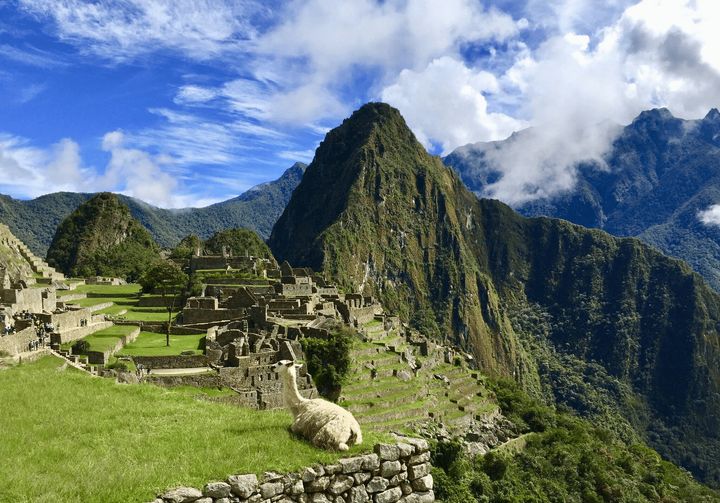Nestled in the cloud forest on the edge of the Peruvian Amazon is the beautiful stone city of Machu Picchu. Rightly known as one of the “Seven Wonders of the World,” Machu Picchu attracts as many as 5000 international guests every day, especially during the peak season from June to August. Due to worldwide interest, guests can choose from multiple routes to reach the “Lost City of the Incas,” featuring fascinating stone monuments and panoramic views of the tropical mountain forest, which the massive structure finds itself tucked away in.
The majority of travelers opt for a scenic train ride to Aguas Calientes, while others dream of trekking to the Incan city, across amazing landscapes and local villages, thus increasing the likelihood to see the sun rise over Machu Picchu. Between entrancing train rides featuring panoramic views and authentic, thrilling trails embedded in the Andes mountain range, the journey to Machu Picchu is destined to be an unforgettable one.

#1. Perurail Train
Entry Point: Aguas Calientes (Machu Picchu Pueblo)
The most popular way to tour Machu Picchu is by train, a spectacular option which saves travelers a lot of time. Step aboard one of the many trains that depart primarily from Ollantaytambo to Aguas Calientes. There are multiple rail lines to choose from, however, the Expedition, Vistadome and Belmond Hiram Bingham are frequently chosen. The Expedition transports passengers to Machu Picchu at an unbeatable price, and the comfortable interior creates an ambiance perfect for kick-starting any Machu Picchu adventure.
While the Vistadome is more expensive in comparison with the Expedition, the majestic views, delightful service and luxurious design are worth every additional penny. Panoramic windows display gorgeous vistas of the Peruvian countryside and the rushing Urubamba River below. Return trips aboard the Vistadome are equally as enjoyable with live music, dance performances and traditional cuisine served inside the train - providing the ultimate Andean experience.
Finally, the Belmond Hiram Bingham is the epitome of exclusive luxury, designed specifically for those seeking 5-star transportation. The train departs Cusco, fully renovated in the style of 1920s Pullman cars, and transforms an already magical journey into an unforgettable one. Revel in the elegant dining car, bar and observatory, where one can bask in the unmatched scenery while sipping a Peruvian cocktail and swaying to local tunes. This train is personalized to every last detail, making it difficult to depart when the time comes.
Note: Regardless of which train-style you choose, it is necessary to take a bus from Aguas Calientes to the entrance of Machu Picchu. Shuttle buses to Machu Picchu leave from the bus terminal in Aguas Calientes as soon as they fill up, from 6:00 in the morning to 5:30 in the afternoon. Once full, the shuttle bus will travel along the rocky mountainside of Peru. Enjoy an adventurous ride, with multiple switchbacks and steep cliffside drops, as you ascend the mountain to Machu Picchu. Choose an aisle seat if heights tend to scare you, otherwise cuddle up to the window for a bus ride unlike any other!

#2. The Classic Inca Trail
Entry Point: Sun Gate
Travelers with time and a lot of energy immediately set their sight on the Inca Trail. Hiking the Inca Trail is an exhilarating experience, ideal for finding otherwise hidden sites that cannot be seen aboard a train or bus. Also, it is the only trail that allows trekkers to follow in the footsteps of the Incas as they enter Machu Picchu through the Sun Gate access point. Walking the great lengths of the Inca Trail and experiencing the leafy cloud forest, rich in Peruvian biodiversity, will take anyone’s breath away - and not solely because of the altitude difference!
There are three different versions of the Inca Trail from which the traveler can choose, depending on how much time one has. The standard length of the Inca Trail trek is four days, though a private, five-day package is also available. The 4-day course starts south of Cusco and is ideal for those interested in long trails, and who are unafraid of brisk nights or rainy weather throughout the day. The companionship built during this hike makes for an extremely memorable experience, and when the sun lights up the sharp edges of Machu Picchu so that the mountain is visibly apparent, all fatigue will convert into utter excitement for what is yet to come.
If a shorter route is calling your name, consider a 2-day Inca Trail package. Take the train from Cusco to kilometer 84 or 88, two starting points situated just before Machu Picchu station. From there, begin a full day of hiking. Climb to Wiñay Wayna (Huinay Huayna) where you can join fellow trekkers in the final stages of the classic 4-day hike. Upon arrival in Aguas Calientes, tired tourists often choose to spend the night in town and use the second day to explore the ruined citadel. Travelers who are limited on time or are not physically able to complete the full, 4-day version of the Inca Trail often choose this option. Though the length of the trail is shorter, guests still experience significant portions of the Inca Trail, the artwork of the stone ruins of Wiñay Wayna and can worry less about adjusting to the altitude.
Note: The Inca Trail leads travelers through the Sun Gate access point into Machu Picchu. After exploring the impressive ruins, you can relax in Aguas Calientes where charming hotels and restaurants await your company.

#3. Alternate Trekking Routes
Entry Point: The Hydroelectric Plant
The Salkantay Trek is considered the best alternative route to the Inca Trail, if not better! This option includes a bus ride from Cusco to Mollepata, where trekkers will begin a 5-day trekking tour through the gorgeous terrain of Salkantay Mountain until arriving at the Hydroelectric Plant. From there, continue on another 2-hour trail to Aguas Calientes and then transfer by bus to Machu Picchu.
The Salkantay Trek is for hiking enthusiasts who wish to become personally integrated into changing environments on a daily basis. Along this hike, stroll through landscapes of snowy mountain paradise to tropical jungle where animals, medicinal plants and flower varieties thrive. Witness the ancient, remote villages that are hardly ever seen by foreigners. Reasonable fitness is required for this trek, but age should never be a barrier! Most importantly, note that the highest part of the Salkantay trek is the Salkantay Pass at 4600 meters. It is here that trekkers can appreciate the stunning peak of Salkantay Mountain, its surrounding small lakes and moraines. Be sure to take two days of acclimatization, exploring the city of Cusco, the nearby Inca ruins or the Sacred Valley, before this trek, to ensure the best experience possible.

Entry Point: The Hydroelectric Plant
For the young and the restless, consider the Santa Teresa Route. This lengthy route to Aguas Calientes is perfect for energetic backpackers and trekkers. Begin in Ollantaytambo, a charming village set on the Urubamba River, and then travel by bus to Santa Teresa. From Santa Teresa board a minibus that transports guests directly to the Hydroelectric Plant. From the Hydroelectric Plant, travelers can trek for another 2 hours to Aguas Calientes where they can catch a bus to Machu Picchu. Though this route may be a bit extensive, trekkers appreciate the low-cost, less crowded atmosphere and the amazing vistas of Veronica Mountain on the way.
Note: There is another bus route that takes guests from Ollantaytambo to Santa Maria. Then, another bus (mini or regular) will transport guests from Santa Maria to Santa Teresa to the Hydroelectric Plant. Depending on the size of bus you board, this trip can take 7+ hours. This is a very complicated option and is not recommended for all travelers.
Lares Valley Trek
Entry Point: Ollantaytambo
Just slightly beyond the Sacred Valley’s northern edge, sits the beautiful Lares Valley. Life here is relatively unchanged from its century-old origins. Locals pass by in traditional Andean dress, plant potatoes by hand, raise herds of llama and alpacas and weave cloth just as they did many generations ago. The farmers and artisans described are some of the only people you will see for days, giving you an incredible opportunity to understand the centuries-old local culture. The Lares Trek typically begins in the tiny town of Lares and takes travelers through several villages. On this journey, marvel at the massive Mount Veronica (18,000 plus feet) and several high-altitude lakes. The end of this trek will lead you into the ruins of Ollantaytambo. From there, the train trip to Machu Picchu is only 90 minutes.
